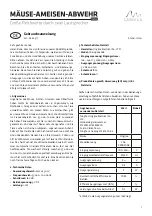
Page | 20
which the deck can be fed and still obtain the necessary separation. When starting
your stoner, always start at the minimum feed rate; obtain your required
separation, then increase the feed rate to the desired capacity.
TILT:
Tilt is the difference in the elevation between the high end of the deck and the low
end of the deck. Increasing tilt will cause the material to shift toward the low end
of the deck. Decreasing tilt will cause the material to shift toward the high end of
the deck. Normally, the best separations are obtained when the tilt is set at or near
the maximum steepness. However, care should be taken not to set the tilt too steep.
The tilt is too steep when material cannot be made to flow toward the high end of
the deck by increasing the eccentric speed. Too little tilt is shown when all the
material moves toward the heavy side of the deck despite a slow eccentric speed. The
tilt is adjusted by loosening the two clamping handles (2) and moving the tilt
adjustment handle (2) in toward the machine for more tilt and away from the
machine for less tilt.
VFD AIR ADJUSTMENT
:
Air regulation is one of the most important adjustments
to be made on a stoner. The most common mistake in air regulation is the use of too
much air. Separation is not made by "blowing" the light material from the heavy but
by using a controlled air flow to create the stratified layers, which are then separated
by the vibrating action of the deck. Too much air will cause a boiling or bubbling
action lifting the heavier particles from the deck and mixing them with the lighter
top layers. Too little air will cause the material to appear sluggish and pile up on the
high end of the deck.
With proper air regulation, the bed of material will be almost fluid in
appearance. With the exception of the stratifying zone under the feeder, the
material on the surface should be agitated and free flowing. Bubbling should be
kept to a minimum, allowing the vibrating deck to make the separation.
Содержание Hi-Cap N Series
Страница 6: ...Page 6 ...
Страница 34: ...Page 34 this section intentionally left blank ...
Страница 35: ...Page 35 V Appendices Appendix A Maintenance and Basic Troubleshooting ...
Страница 41: ...Page 41 Appendix B The ABB ACS380 VFD ...
Страница 42: ...42 P a g e The ABB ACS380 VFD B 1 Getting to know the VFD Keypad Figure 16 VFD keypad overview ...
Страница 43: ...43 P a g e Figure 17 VFD keypad display ...
Страница 44: ...44 P a g e Figure 18 VFD keypad status line ...
Страница 47: ...47 P a g e A 2 Programming the VFD from the Keypad Figure 20 Changing VFD parameters ...
Страница 49: ...49 P a g e ...
Страница 50: ...50 P a g e Appendix C Timer manual ...
Страница 51: ...51 P a g e C 1 Getting to know timer operation ...
Страница 52: ...52 P a g e C 2 Timer dip switch selection ...
Страница 53: ...53 P a g e Appendix D Electrical and Dimensional drawings ...
Страница 54: ...Page 54 D 1 Electrical drawings ...
Страница 55: ...55 P a g e ...
Страница 56: ...56 P a g e ...
Страница 57: ...57 P a g e D 2 DIMENSIONAL LAYOUT DRAWINGS ...
Страница 58: ......
















































